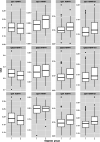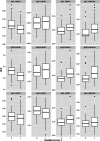Baseline IgG-Fc N-glycosylation profile is associated with long-term outcome in a cohort of early inflammatory arthritis patients
- PMID: 36008868
- PMCID: PMC9404591
- DOI: 10.1186/s13075-022-02897-5
Baseline IgG-Fc N-glycosylation profile is associated with long-term outcome in a cohort of early inflammatory arthritis patients
Abstract
Background: Rheumatoid arthritis (RA) is a chronic autoimmune disease for which prediction of long-term prognosis from disease's outset is not clinically feasible. The importance of immunoglobulin G (IgG) and its Fc N-glycosylation in inflammation is well-known and studies described its relevance for several autoimmune diseases, including RA. Herein we assessed the association between IgG N-glycoforms and disease prognosis at 2 years in an early inflammatory arthritis cohort.
Methods: Sera from 118 patients with early inflammatory arthritis naïve to treatment sampled at baseline were used to obtain IgG Fc glycopeptides, which were then analyzed in a subclass-specific manner by liquid chromatography coupled to mass spectrometry (LC-MS). Patients were prospectively followed and a favorable prognosis at 2 years was assessed by a combined index as remission or low disease activity (DAS28 < 3.2) and normal functionality (HAQ ≤ 0.25) while on treatment with conventional synthetic DMARDs and never used biologic DMARDs.
Results: We observed a significant association between high levels of IgG2/3 Fc galactosylation (effect 0.627 and adjusted p value 0.036 for the fully galactosylated glycoform H5N4F1; effect -0.551 and adjusted p value 0.04963 for the agalactosylated H3N4F1) and favorable outcome after 2 years of treatment. The inclusion of IgG glycoprofiling in a multivariate analysis to predict the outcome (with HAQ, DAS28, RF, and ACPA included in the model) did not improve the prognostic performance of the model.
Conclusion: Pending confirmation of these findings in larger cohorts, IgG glycosylation levels could be used as a prognostic marker in early arthritis, to overcome the limitations of the current prognostic tools.
Keywords: Fragment crystallizable; Immunoglobulin G; Inflammation; N-glycosylation; Rheumatoid arthritis.
© 2022. The Author(s).
Conflict of interest statement
G.L. is the founder and owner of Genos Ltd, a private research organization that specializes in high-throughput glycomic analyses and has several patents in this field. F.V., M.P-B., and M.P. are employees of Genos Ltd. All other authors declare no conflict of interest.
Figures


Similar articles
-
IgG Fc galactosylation predicts response to methotrexate in early rheumatoid arthritis.Arthritis Res Ther. 2017 Aug 9;19(1):182. doi: 10.1186/s13075-017-1389-7. Arthritis Res Ther. 2017. PMID: 28793911 Free PMC article.
-
The Role of IgG Fc Region N-Glycosylation in the Pathomechanism of Rheumatoid Arthritis.Int J Mol Sci. 2022 May 23;23(10):5828. doi: 10.3390/ijms23105828. Int J Mol Sci. 2022. PMID: 35628640 Free PMC article.
-
Distinct Longitudinal Changes in Immunoglobulin G N-Glycosylation Associate with Therapy Response in Chronic Inflammatory Diseases.Int J Mol Sci. 2022 Jul 30;23(15):8473. doi: 10.3390/ijms23158473. Int J Mol Sci. 2022. PMID: 35955616 Free PMC article.
-
Sweet but dangerous - the role of immunoglobulin G glycosylation in autoimmunity and inflammation.Lupus. 2016 Jul;25(8):934-42. doi: 10.1177/0961203316640368. Lupus. 2016. PMID: 27252272 Review.
-
[Defect of glycosylation of immunoglobulin G in rheumatoid arthritis patients].Postepy Hig Med Dosw (Online). 2005;59:485-9. Postepy Hig Med Dosw (Online). 2005. PMID: 16258413 Review. Polish.
Cited by
-
IgG subclass and Fc glycosylation shifts are linked to the transition from pre- to inflammatory autoimmune conditions.Front Immunol. 2022 Nov 3;13:1006939. doi: 10.3389/fimmu.2022.1006939. eCollection 2022. Front Immunol. 2022. PMID: 36405742 Free PMC article. Review.
-
Neutrophil Depletion Changes the N-Glycosylation Pattern of IgG in Experimental Murine Sepsis.Int J Mol Sci. 2024 Jun 12;25(12):6478. doi: 10.3390/ijms25126478. Int J Mol Sci. 2024. PMID: 38928183 Free PMC article.
-
The importance of IgG glycosylation-What did we learn after analyzing over 100,000 individuals.Immunol Rev. 2024 Nov;328(1):143-170. doi: 10.1111/imr.13407. Epub 2024 Oct 4. Immunol Rev. 2024. PMID: 39364834 Free PMC article. Review.
References
Publication types
MeSH terms
Substances
LinkOut - more resources
Full Text Sources
Medical

